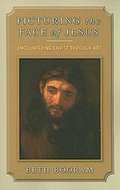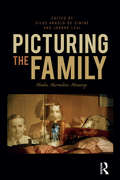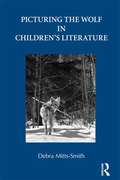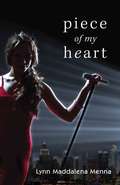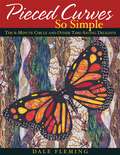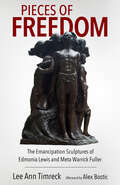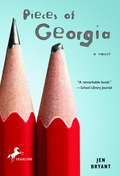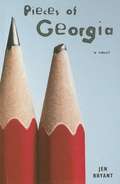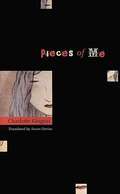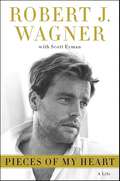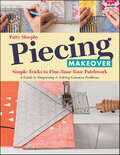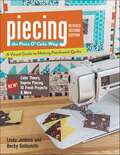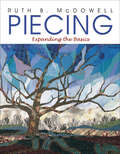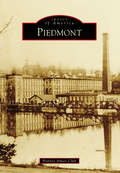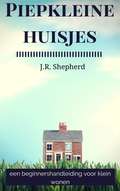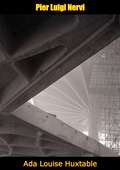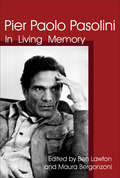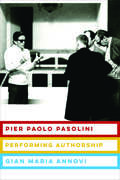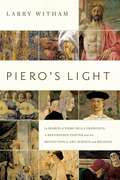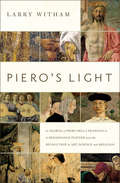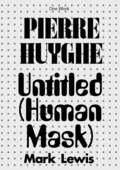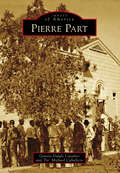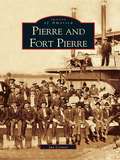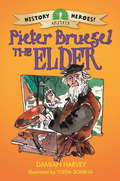- Table View
- List View
Picturing the Face of Jesus: Encountering Christ through Art
by Beth BooramFor many who identify themselves as Christians, Jesus has never become experientially personal or real. Countless others who have faithfully followed Christ confess to a spiritual dryness and lack of joy. These individuals are weary and unmoved by the plethora of information about Jesus. What they long for is an experience with Jesus.Picturing the Face of Jesus is an invitation to experience Christ more deeply. Through a rich palette of experiential media—art contemplation, gospel story-telling, and imaginative prayer—the reader is invited to picture the face of Jesus, his expressive, one-of-a-kind, human face. As a result, Jesus will become a real person with whom they candidly relate, instead of a hero they merely admire. Through this encounter, their own hearts will be transformed as they begin to reflect the face of Christ to others.
Picturing the Family: Media, Narrative, Memory
by Silke Arnold-de Simine; Joanne LealWhether pasted into an album, framed or shared on social media, the family photograph simultaneously offers a private and public insight into the identity and past of its subject. Long considered a model for understanding individual identity, the idea of the family has increasingly formed the basis for exploring collective pasts and cultural memory. Picturing the Family investigates how visual representations of the family reveal both personal and shared histories, evaluating the testimonial and social value of photography and film.Combining academic and creative, practice-based approaches, this collection of essays introduces a dialogue between scholars and artists working at the intersection between family, memory and visual media. Many of the authors are both researchers and practitioners, whose chapters engage with their own work and that of others, informed by critical frameworks. From the act of revisiting old, personal photographs to the sale of family albums through internet auction, the twelve chapters each present a different collection of photographs or artwork as case studies for understanding how these visual representations of the family perform memory and identity. Building on extensive research into family photographs and memory, the book considers the implications of new cultural forms for how the family is perceived and how we relate to the past. While focusing on the forms of visual representation, above all photographs, the authors also reflect on the contextualization and ‘remediation’ of photography in albums, films, museums and online.
Picturing the Wolf in Children's Literature (Children's Literature and Culture #69)
by Debra Mitts-SmithFrom the villainous beast of “Little Red Riding Hood” and “The Three Little Pigs,” to the nurturing wolves of Romulus and Remus and Rudyard Kipling’s The Jungle Book, the wolf has long been a part of the landscape of children’s literature. Meanwhile, since the 1960s and the popularization of scientific research on these animals, children’s books have begun to feature more nuanced views. In Picturing the Wolf in Children’s Literature, Mitts-Smith analyzes visual images of the wolf in children’s books published in Western Europe and North America from 1500 to the present. In particular, she considers how wolves are depicted in and across particular works, the values and attitudes that inform these depictions, and how the concept of the wolf has changed over time. What she discovers is that illustrations and photos in works for children impart social, cultural, and scientific information not only about wolves, but also about humans and human behavior. First encountered in childhood, picture books act as a training ground where the young learn both how to decode the “symbolic” wolf across various contexts and how to make sense of “real” wolves. Mitts-Smith studies sources including myths, legends, fables, folk and fairy tales, fractured tales, fictional stories, and nonfiction, highlighting those instances in which images play a major role, including illustrated anthologies, chapbooks, picture books, and informational books. This book will be of interest to children’s literature scholars, as well as those interested in the figure of the wolf and how it has been informed over time.
Piece of My Heart
by Lynn Maddalena MennaStill in high school, Marisol Reyes gets the chance of a lifetime to be a real singer, and she leaps at it. After all, this is the dream she held on to, all the days and nights she spent growing up on means streets of East Harlem. Marisol never gave in--no matter what her boyfriend or her best friend had to say. Who cares if only one in a hundred pretty, talented girls make it? She will be the one. In her rush to fame, Marisol tramples on the heart of her loyal best friend, and Julian, the boy she loves. But will it be worth it?One night at a private gig in the Hamptons, the little Latino girl with the big voice from East Harlem gets a severe reality check. A famous rapper who claims to be interested in her talents turns out to be interested in something else, threatening not only Marisol's dreams but her body and soul. Will the realities of the gritty New York music scene put out the stars in Marisol's eyes forever?
Pieced Curves So Simple: The 6-Minute Circle and Other Time-Saving Delights
by Dale FlemingStitch Circles and Curves - the Fast, Accurate, EASY Way! • Dale's fast, easy, pinless technique really works for machine-sewing curves and circles • Think like a designer - Dale demystifies color, balance, unity, and more! • Design-as-you-go techniques bring out your creativity • Discover a variety of easy ways to make your own patterns
Pieces of Freedom: The Emancipation Sculptures of Edmonia Lewis and Meta Warrick Fuller (Margaret Walker Alexander Series in African American Studies)
by Lee Ann TimreckThe history of racism in America is also the history of ordinary Black Americans who accomplished extraordinary things in their pursuit of freedom. Faced with oppression throughout their journey, they built vibrant communities and lived purposeful lives. Pieces of Freedom: The Emancipation Sculptures of Edmonia Lewis and Meta Warrick Fuller brings that history to life by analyzing the first fifty years of Black freedom through the emancipation sculptures of two nineteenth-century African American sculptors, Mary Edmonia Lewis (1844–1909) and Meta Warrick Fuller (1877–1968).Lewis's and Fuller’s sculptures—and their visual narrative of a people’s strength and humanity in the face of oppression—present a textured historical diorama of Black life during an era of transformative, yet sorrowful, events. In this book, Lee Ann Timreck integrates Lewis's and Fuller’s visual narrative with oral narratives of the newly emancipated, all set within the historical context of Reconstruction, segregation, and Jim Crow. The sculptures also reflect the artists’ gendered perspective of emancipation, conveying a strong narrative on the contributions and sacrifices made by newly freed Black women. These emancipation sculptures provide both a historical narrative of the Black emancipation experience and a moral narrative of America’s failure to create a nation where “all men are created equal.” Pieces of Freedom challenges the twenty-first-century reader to learn and accept this history so we might address our nation’s lingering social and economic injustices.
Pieces of Georgia
by Jen BryantLike her mother, Georgia McCoy is an artist, but her dad looks away whenever he sees her with a sketchbook. Sometimes it’s hard to remember what it was like when her mother was still alive . . . when they were a family . . . when they were happy. But then a few days after her 13th birthday, Georgia receives an unexpected gift–a strange, formal letter, all typed up and signed anonymous–granting her free admission to the Brandywine River Museum for a whole year. And things begin to change. An accessible novel in poems, Pieces of Georgia offers an endearing protagonist–an aspiring artist, a grieving daughter, a struggling student, a genuine friend–and the poignant story of a broken family coming together. From the Hardcover edition.
Pieces of Georgia
by Jennifer BryantIn journal entries to her mother, a gifted artist who died suddenly, thirteen-year-old Georgia McCoy reveals how her life changes after she receives an anonymous gift membership to a nearby art museum.
Pieces of Me
by Charlotte Gingras Susan OuriouMirabelle's art teacher tells her she has talent, but what good is it doing her. Almost fifteen and friendless, Mira is plagued by dark thoughts. Her body seems to be changing daily. Her mother is domineering and half-crazy and her father -- well, he's her ex-father, mostly out of Mira's life and awkward when he's around.
Pieces of My Heart: A Life
by Robert J. Wagner Scott EymanThe Hollywood icon tells about his rise to Hollywood stardom among legends like Cary Grant and Barbara Stanwyck and his troubled marriage, divorce, and remarriage to starlet Natalie Wood.In the revelation-filled memoir from one of Hollywood’s most talented actors, readers have a candid and deeply personal look at the life and career of Robert Wagner. Wagner’s long career began in the Hollywood of the 1950s, when studios were dominant and even the love lives of actors were dictated by what benefited the studio. His memoirs will chronicle in a very personal way his rise to stardom, his decline, and his resurrection. Wagner will talk candidly about his famous relationship with Natalie Wood and the circumstances surrounding her tragic death. His friendships and stories include major Hollywood personalities in the last half of the 20th century.When his family moved to Los Angeles, a young Wagner held a variety of jobs (including one as a caddy for Clark Gable) while pursuing his goal, but it was while dining with his parents at a restaurant in Beverly Hills that he was “discovered” by a talent scout.Known as much for his on-screen abilities as his off-screen personal heartbreak, Wagner will discuss for the first time his complicated and ultimately tragic relationship with Hollywood sweetheart Natalie Wood. It was implied that Wagner played a role in Natalie Wood’s tragic drowning off the coast of Catalina Island in 1981 and Wagner, for the first time ever, will set the record straight.With at least two dozen photos to illustrate his real Hollywood-style tell-all, this will be the extremely candid autobiography of Robert Wagner.
Piecing Makeover: Simple Tricks to Fine-Tune Your Patchwork
by Patty MurphyDo your quilt blocks tend to misbehave? Perfect your patchwork with a visual, step-by-step guide to 21 popular quilt blocks. Piecing expert Patty Murphy shows you how with fail-proof techniques that can be used in all types of quilt designs, from traditional to modern. Say goodbye to patchwork problems like mismatched seams, blunt points, and too-small blocks, and learn to avoid common mistakes in sashings, borders, and bindings. Though mistakes happen to all of us, these easy techniques will help beginning and intermediate quilters achieve quiltmaking success every time. • Learn to flawlessly construct 21 popular blocks in both traditional and modern designs • Step-by-step photos guide new and intermediate quilters • Avoid common patchwork problems like mismatched seams with expert tips from a lifelong quilter
Piecing the Piece O' Cake Way: A Visual Guide to Making Patchwork Quilts
by Becky Goldsmith Linda JenkinsThe Only Patchwork Basics Book You’ll Need From planning to binding, learn the right way to do patchwork with best-selling authors from Piece O’ Cake Designs. Before they taught appliqué, Linda Jenkins and Becky Goldsmith shared a love of—piecing and they’re still avid patch workers today! Start with simple strips, squares, and half-square triangles. Then stretch your skills with diamonds, curves, and improv piecing. This visual guide to quiltmaking basics includes 10 colorful projects, skill-building techniques, and tips for fabulous fabric selection. • Everything you need to know about quiltmaking from patchwork experts from Piece O’ Cake Designs • Expanded second edition! New quilts, improved techniques, and color choices made easy • Handy, visual guide lies flat for easy reference • Complete guide to quilting basics including sewing scant quarter-inch seams, cutting fabric that’s larger than your cutting mat, sewing perfectly placed points, and more
Piecing: Expanding The Basics
by Ruth B. McDowellThe renowned quilt artist and author of Ruth McDowell’s Piecing Workshop offers an advanced class in piecing for quilters who have mastered the basics.Almost everyone who views a Ruth McDowell quilt wants to know, “How did she piece that?” Now Ruth shares her sought-after techniques for piecing curved seams, insets, multiple angles, Z seams, Y seams, puzzle seams, diagonals, intersecting seams, slipped seams, and much more. Beginning with a photo or sketch, Ruth walks you through the individual steps of piecing and offers problem-solving suggestions along the way. You’ll learn her methods for original piecing design, as well as how to select fabrics and find your own working style. This book will appeal to traditional and contemporary quiltmakers alike.
Piedmont (Images of America)
by Bonnes Amies ClubAstride a mighty river separating Greenville and Anderson Counties in the foothills of the Blue Ridge Mountains, Piedmont is a place divided--divided by a river, a county line, and school district lines. But, more importantly, it is tied, connected, and bridged together by its enduring story. Swift and deep, the Saluda River attracted Native Americans, Revolutionary War soldiers, and early settlers to the ford at the shoals. Called Big Shoals of the Saluda by the Cherokee and Garrison Shoals by the settlers, the ford supported a British garrison, an early gristmill, and a venture into textile manufacturing. In fact, Piedmont Manufacturing Company was one of the earliest and largest mills in the South. Today, still spanning the Saluda and linking the mill sites to allow swift crossing, the footbridge connects today's residents to the souls these waters have affected for hundreds of years.
Piepkleine huisjes: een beginnershandleiding voor klein wonen
by Ynze Bakker J. R. ShepherdLeef gelukkig door klein te wonen! Heb jij je ooit afgevraagd hoe het zou zijn om in een piepklein huisje te wonen? Droom je van een lagere hypotheek? Of helemaal geen hypotheek? Vind je "groen" leven belangrijk? Wil je wat eenvoudiger wonen en je concentreren op de dingen in het leven die echt belangrijk zijn? Dan zou een piepklein huisje voor jou de perfecte oplossing kunnen zijn! Dit boek verkent piepkleine huisjes en de levensstijl die ermee gepaard gaat. Het geeft jou een idee of een piepklein huisje nuttig is voor jou en helpt je bij de overgang naar het idee van groot wonen in een kleine ruimte. In piepkleine huisjes: een beginnershandleiding voor klein wonen leer je: - Voor wie piepkleine huisjes het meest geschikt zijn; - Hoe piepkleine huisjes jou helpen om jouw onnodige bezittingen te verminderen en je te concentreren op de dingen in het leven die echt belangrijk voor jou zijn; - Tips voor het ontwerpen en inrichten om je te helpen het meeste te halen uit de ruimte in jouw piepkleine huisje; - De fysieke en emotionele voordelen van het adopteren van de piepkleine huisjes levensstijl; - En nog veel meer! Piepkleine huisjes gaan over het je concentreren op wat het belangrijkst is voor jou - relaties, hobby's, werk, natuur of gemeenschap. Het is nooit te laat om je op iets anders te concentreren, en piepkleine huisjes: een beginnershandleiding voor klein wonen, helpt je om dat te bereiken! Leef gelukkig door klein te wonen!
Pier Luigi Nervi: Masters Of World Architecture
by Ada Louise HuxtableThis book by Pulitzer-Prize-winning critic Ada Louise Huxtable is a monograph on the great Italian architect and structural engineer Pier Luigi Nervi (1891-1979), which was first published in 1960.PIER LUIGI NERVI was born in Sandrio, Italy, on June 21, 1891. He completed his formal studies at the civil engineering school of the University of Bologna in 1913. After graduating, he worked for the Società per Costruzioni Cementizie until 1920, receiving thorough experience in the design of reinforced concrete. In 1920 he formed the partnership of Soc. Ing. Nervi e Nebbiosi. During this association, which lasted until 1932, several noteworthy structures were built, especially the Florence Municipal Stadium. In 1932 he joined with a cousin to form Ingg. Nervi e Bartoli, the design and construction firm which he headed; the famous airplane hangars of 1938-1943, won by the firm in competition, brought Nervi international attention.In the mid-1940s he developed the versatile material “Ferro-cementa,” a system of layers of fine steel mesh sprayed with cement mortar, which he used in the extraordinary Grand Salon of the Turin Exhibition Hall (1949). With this, building, Nervi became firmly established as one of the world’s foremost engineers, a reputation reinforced again and again by subsequent works, including the completion of three stadia for the 1960 Olympics in Rome.A member of the International Congresses of Modern Architecture (CIAM), he was also Professor of Technology and Construction Techniques at the University of Rome. He was awarded Gold Medals by the Institution of Structural Engineers in the UK, the American Institute of Architects (AIA Gold Medal 1964) and the RIBA. In 1957, he received the Frank P. Brown Medal of The Franklin Institute and the Wilhelm Exner Medal.Pier Luigi Nervi died on January 9, 1979 at the age of 87.
Pier Paolo Pasolini: In Living Memory
by Ben Lawton and Maura BergonzoniA collection of essays discussing the famed Italian film director, writer, and intellectual.More than thirty years after the tragic death of Pier Paolo Pasolini, this volume is intended to acknowledge the significance of his living memory. His artistic and cultural production continues to be a fundamental reference point in any discourse on the state of the arts, and on contemporary political events, in Italy and abroad. This collection of essays intends to continue the recognition of Pasolini’s teachings and of his role as engaged intellectual, not only as acute observer of the society in which he lived, but also as semiologist, writer, and filmmaker, always heretical in all his endeavors. Many directors, reporters, and contemporary writers see in the “inconvenient intellectual” personified by Pasolini in his writings, in his films, and in his interviews, an emblematic figure with whom to institute and maintain a constant dialog, both because of the controversial topics he addressed, which are still relevant today, and because of the ways in which he confronted the power structures. His analytical ability made it impossible for him to believe in the myth of progress; instead, he embraced an ideal that pushed him always to struggle on the firing line of controversy.
Pier Paolo Pasolini: Performing Authorship
by Gian Maria AnnoviBefore his mysterious murder in 1975, Pier Paolo Pasolini had become famous—and infamous—not only for his groundbreaking films and literary works but also for his homosexuality and criticism of capitalism, colonialism, and Western materialism. In Pier Paolo Pasolini: Performing Authorship, Gian Maria Annovi revisits Pasolini's oeuvre to examine the author's performance as a way of assuming an antagonistic stance toward forms of artistic, social, and cultural oppression. Annovi connects Pasolini's notion of authorship to contemporary radical artistic practices and today's multimedia authorship.Annovi considers the entire range of Pasolini's work, including his poetry, narrative and documentary film, dramatic writings, and painting, as well as his often scandalous essays on politics, art, literature, and theory. He interprets Pasolini's multimedia authorial performance as a masochistic act to elicit rejection, generate hostility, and highlight the contradictions that structure a repressive society. Annovi shows how questions of authorial self-representation and self-projection relate to the artist's effort to undermine the assumptions of his audience and criticize the conformist practices that the culture industry and mass society impose on the author. Pasolini reveals the critical potential of his spectacular celebrity by using the author's corporeal or vocal presence to address issues of sexuality and identity, and through his strategic self-fashioning in films, paintings, and photographic portraits he destabilizes the audience's assumptions about the author.
Piero's Light
by Larry WithamIn the tradition of The Swerve and Galileo's Daughter, Piero's Light reveals how art, religion and science came together at the dawn of the modern world in the paintings of one remarkable artist.An innovative painter in the early generation of Renaissance artists, Piero dell Francesca was also an expert on religious topics and a mathematician who wanted to use perspective and geometry to make painting a &“true science.&” Although only sixteen of Piero&’s works survive, few art historians doubt his importance in the Renaissance. A 1992 conference of international experts meeting at the National Gallery of Art deemed Piero, &“One of the most highly regarded painters of the early Renaissance, and one of the most respected artists of all time.&” In recent years, the quest for Piero has continued among intrepid scholars, and Piero's Light uncovers the life of this remarkable artistic revolutionary and enduring legacy of the Italian Renaissance.
Piero's Light: In Search of Piero della Francesca: A Renaissance Painter and the Revolution in Art, Science and Religion
by Larry WithamAn innovative painter in the early generation of Renaissance artists, Piero dell Francesca was also an expert on religious topics and a mathematician who wanted to use perspective and geometry to make painting a "true science."Although only sixteen of Piero's works survive, few art historians doubt his importance in the Renaissance. A 1992 conference of international experts meeting at the National Gallery of Art deemed Piero "one of the most highly regarded painters of the early Renaissance, and one of the most respected artists of all time." In recent years, the quest for Piero has continued among intrepid scholars, and Piero's Light uncovers the life of this remarkable artistic revolutionary and enduring legacy of the Italian Renaissance.
Pierre Huyghe: Untitled (Human Mask) (Afterall Books / One Work)
by Mark LewisAn examination of Pierre Huyghe's post-apocalyptic Untitled (Human Mask), which asks whether our human future may be one of remnants and mimicry.Pierre Huyghe's 2014 film Untitled (Human Mask) combines images of a post-apocalyptic world (actual footage of deserted streets close to the Fukushima Daiichi nuclear disaster of March 2011) with a haunting scene of a monkey working in an empty restaurant wearing a human mask and a wig. She's a girl! The flat, emotionless almost automaton state of the mask and the artificial glossy hair topped even with a child's bow, suggests that she, the monkey, might be a character from Japanese Noh theatre. But there's no music. Instead Huyghe's film evinces the terrifying possibility that our own, human, future might just be one of remnants and mimicry; that the deserted streets of Fukushima and the monkey's recognizable, alienating chimeric performance is all that might survive us. Untitled (Human Mask) presents a pluperfect world with extinction the endgame for a civilization that cared little for the present, dreaming only of a future that inevitably and necessarily could not include it.
Pierre Part
by Tre' Michael Caballero Geneve Daigle CavalierPierre Part and Belle River rest in an area once known as the Atchafalaya Basin. Between 1770 and 1773, a young Canadian named Pierre Part set foot on the banks of what he called La Bay de Lac Verret. He was with the Spanish colonial militia under the command of Commandant Nicholas Verret Sr., a French Canadian. Part considered this place a beautiful wilderness and asked his superior for permission to establish a settlement--his request was not granted. The military returned Part to the Spanish military post at Valenzuela, and although he never made this area his home, his name remains. Other French explorers came much earlier than Part, and some of the area's waterways bear French names: Le Belle Rivere, Le Lac de Natchez, Bayou de Magazille, Bayou de Lantania (Palmetto), Bayou de Postillion, Le Lac de Palourde, and Le Bayou Milhomme. In 1780, Acadian French-speaking people moved to Pierre Part from Burlie des Olivers and Burlie Saint Vincent. Small groups came and settled together at various places within sight of each other. In 1803, a small settlement of families, which is believed to have included the Solors and Berthelots and later the Heberts and the Pipsairs, settled on the banks of Lake Verret, where Bayou Pierre Part flows into the lake.
Pierre and Fort Pierre (Images of America)
by Jan CerneyFrom prairie to river's edge, the Pierre and Fort Pierre area resounds with historical adventure. Visited in 1743 by French explorers-the Verendrye brothers-and by Lewis and Clark in 1804, Fort Pierre was established as a significant fur trading post in 1817 and served briefly as a military fort in 1855. The decaying port settlement was revived during the Black Hills gold rush of 1875, outfitting bull trains. For over a decade, it bustled with freighting activity and stagecoach travel on the Fort Pierre-Deadwood gold trail. When the Chicago, Northwestern Railroad reached the Missouri River in 1880, Fort Pierre's sister city, Pierre, emerged as an important river town. During the days of the open range, Fort Pierre served as a holding place for the millions of cattle to be ferried across the Missouri to the trains at Pierre. In 1889, Pierre was named capital of the state and became the political heart of South Dakota. When nearby reservations opened for settlement, the cattle range began to fill with settlers, changing the scene once again. In these pages, a pictorial history unfolds, the drama of men and women who lived out their dreams near the Missouri.
Pieter Bruegel the Elder (History Heroes #7)
by Damian HarveyPieter Bruegel, the greatest Flemmish painter of the 16th Century, developed a unique style of painting and created many masterpieces, often painting scenes of daily life.Discover the stories of people who have helped to shape history, ranging from early explorers such as Christopher Columbus to more modern figures like Tim Berners-Lee, inventor of the World Wide Web.These chapter books combine historical fact with engaging narrative and humourous illustration, perfect for the newly independent reader.
Pieter Bruegel’s Historical Imagination
by Stephanie PorrasThe question of how to understand Bruegel’s art has cast the artist in various guises: as a moralizing satirist, comedic humanist, celebrator of vernacular traditions, and proto-ethnographer. Stephanie Porras reorients these apparently contradictory accounts, arguing that the debate about how to read Bruegel has obscured his pictures’ complex relation to time and history. Rather than viewing Bruegel’s art as simply illustrating the social realities of his day, Porras asserts that Bruegel was an artist deeply concerned with the past. In playing with the boundaries of the familiar and the foreign, history and the present, Bruegel’s images engaged with the fraught question of Netherlandish history in the years just prior to the Dutch Revolt, when imperial, religious, and national identities were increasingly drawn into tension. His pictorial style and his manipulation of traditional iconographies reveal the complex relations, unique to this moment, among classical antiquity, local history, and art history. An important reassessment of Renaissance attitudes toward history and of Renaissance humanism in the Low Countries, this volume traces the emergence of archaeological and anthropological practices in historical thinking, their intersections with artistic production, and the developing concept of local art history.
